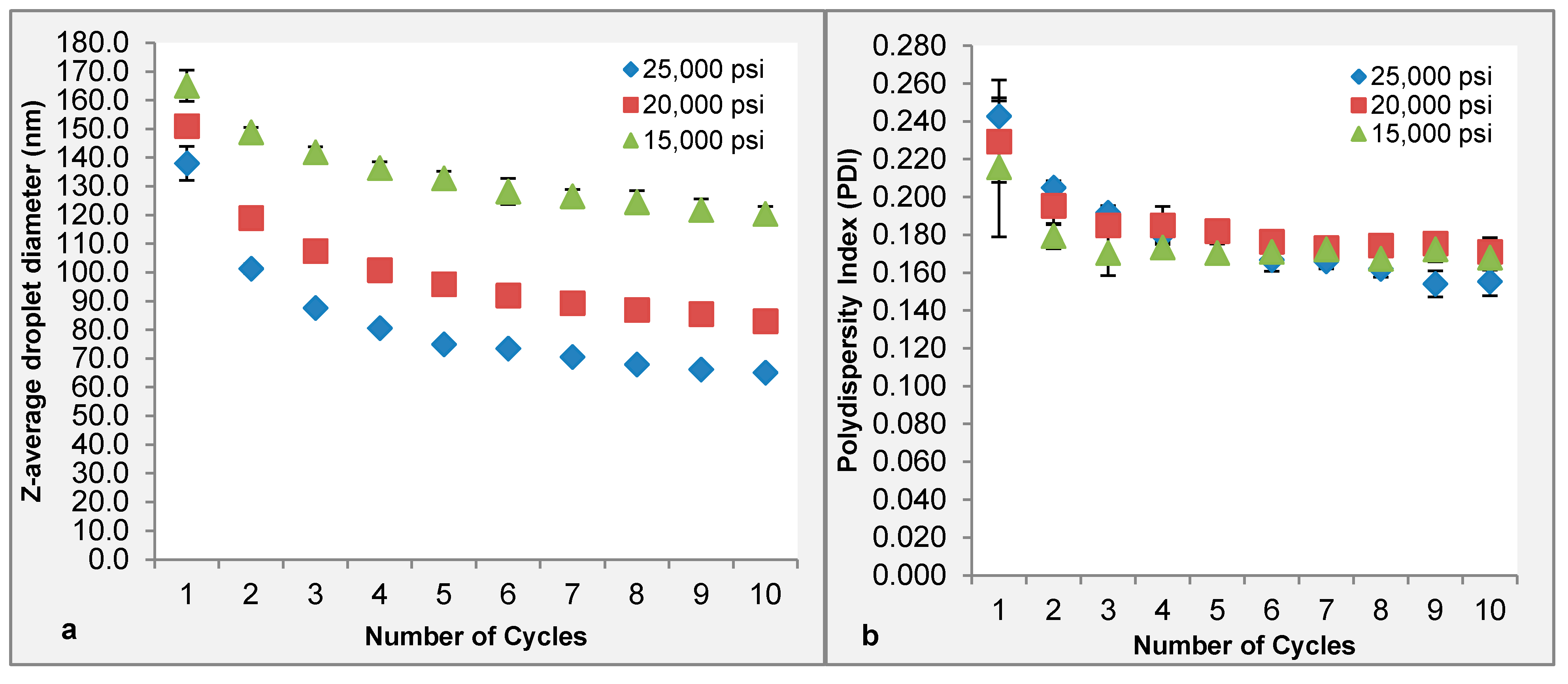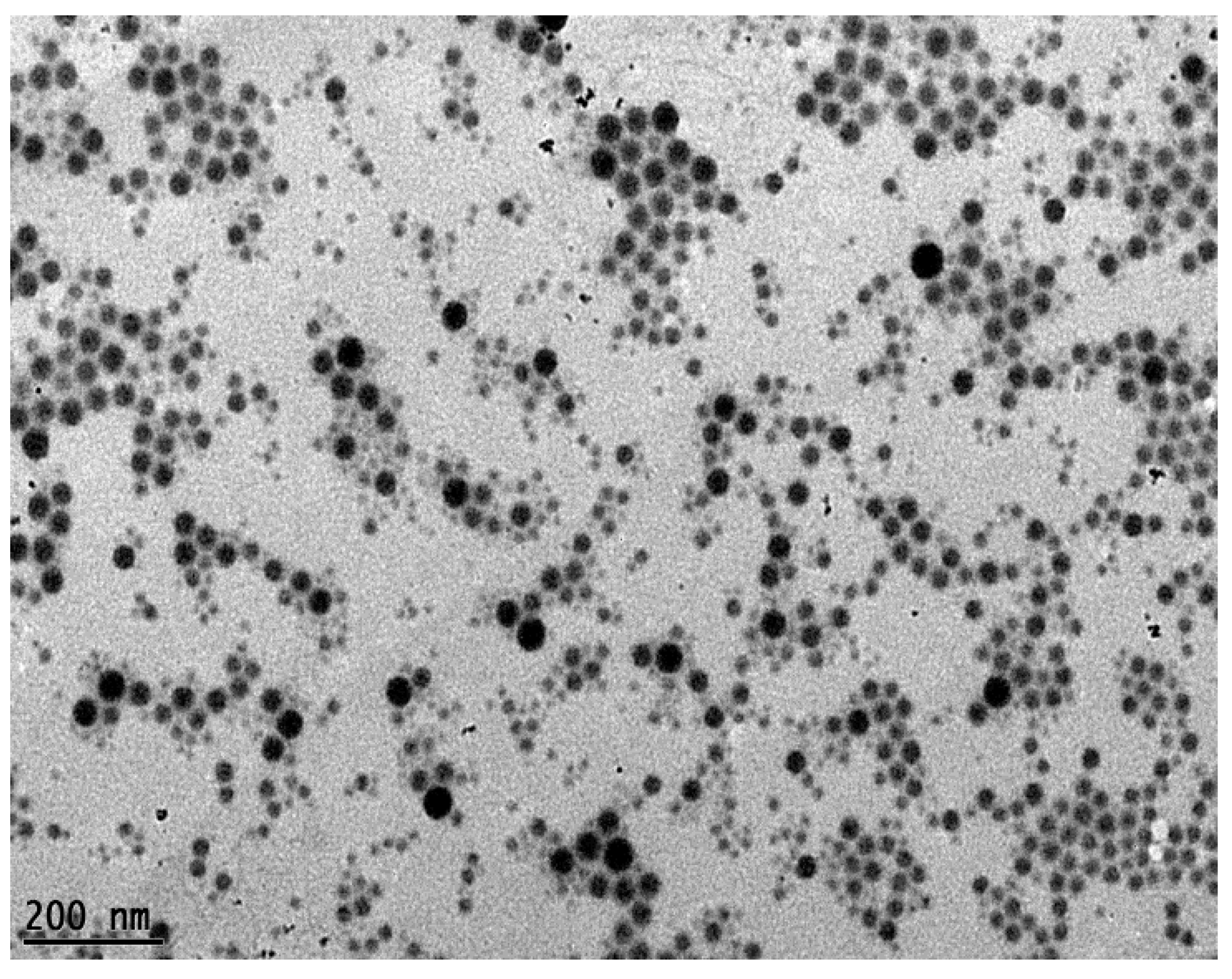Production of Nanoemulsions from Palm-Based Tocotrienol Rich Fraction by Microfluidization
Abstract
:1. Introduction
2. Results and Discussion
2.1. Effect of Microfluidization Conditions on Droplet Size and PDI of TRF Nanoemulsions


2.2. Effect of Different Emulsifiers on the Physical Properties of TRF Nanoemulsions and Tocols Content
| Emulsifier | HLB Value | Z-Average Diameter (nm) * | PDI * | ζ-Potential (mV) * |
|---|---|---|---|---|
| Tween 20 | 16.7 | 55.9 ± 0.8 d,e | 0.154 ± 0.007 c | −37.2 ± 3.4 a,b |
| Tween 40 | 15.6 | 72.2 ± 0.8 b,c,d | 0.169 ± 0.003 c | −32.5 ± 1.1 a |
| Tween 60 | 14.9 | 90.8 ± 4.2 b | 0.185 ± 0.011 b,c | −30.7 ± 0.7 a |
| Tween 80 | 15.0 | 78.3 ± 1.5 b,c | 0.163 ± 0.0 c | −39.1 ± 1.6 a,b |
| Brij 35 | 16.9 | 44.0 ± 1.0 e | 0.561 ± 0.037 a | −42.8 ± 2.4 b,c |
| Span 80:Tween 20 (0.4:0.6 w/w) | 11.74 | 192.9 ± 8.6 a | 0.232 ± 0.025 b | −54.6 ± 1.1 d |
| Span 80:Tween 40 (0.4:0.6 w/w) | 11.08 | 177.0 ± 1.8 a | 0.199 ± 0.003 b,c | −51.2 ± 7.7 c,d |
| Span 80:Tween 60 (0.4:0.6 w/w) | 10.66 | 189.3 ± 9.4 a | 0.198 ± 0.011 b,c | −51.5 ± 2.6 c,d |
| Span 80:Tween 80 (0.4:0.6 w/w) | 10.72 | 195.3 ± 18.8 a | 0.231 ± 0.010 b | −58.3 ± 4.2 d |
| Span 80:Brij 35 (0.4:0.6 w/w) | 11.86 | 66.0 ± 1.9 c,d | 0.173 ± 0.029 c | −39.9 ± 2.1 a,b |
| Emulsifier | Before Microfluidization (mg/g) * | After Microfluidization (mg/g) | Percentage Loss of Tocols (%) ** |
|---|---|---|---|
| Tween 20 | 730.7 ± 41.5 | 653.3 ± 11.0 | 10.5 ± 3.7 a |
| Tween 40 | 712.8 ± 39.7 | 684.7 ± 34.0 | 3.9 ± 1.0 a |
| Tween 60 | 727.5 ± 3.5 | 675.3 ± 17.1 | 7.2 ± 2.4 a |
| Tween 80 | 811.7 ± 9.7 | 777.6 ± 19.7 | 4.2 ± 1.3 a |
| Brij 35 | 737.0 ± 60.6 | 677.1 ± 73.8 | 8.2 ± 2.9 a |
| Span 80:Brij 35 (0.4:0.6 w/w) | 708.3 ± 44.5 | 530.0 ± 23.1 | 25.1 ± 2.7 b |
2.3. Physical Stability of TRF Nanoemulsions during Storage
3. Experimental Section
3.1. Materials
3.2. Preparation of TRF Nanoemulsions
| Storage Duration (Days) | 0 * | 7 | 14 | 21 | 28 | ||||
|---|---|---|---|---|---|---|---|---|---|
| (a) Emulsion prepared by Tween 20: | |||||||||
| Storage temperature (°C) | 25 | 4 | 25 | 4 | 25 | 4 | 25 | 4 | 25 |
| Z-average diameter (nm) | 72.5 ± 1.3 | 70.7 ± 1.8 | 73.4 ± 1.3 | 71.1 ± 1.6 | 73.6 ± 1.1 | 69.2 ± 1.8 | 72.8 ± 0.7 | 70.2 ± 1.3 | 73.9 ± 0.2 |
| PDI | 0.146 ± 0.006 | 0.151 ± 0.003 | 0.144 ± 0.003 | 0.151 ± 0.007 | 0.140 ± 0.005 | 0.151 ± 0.000 | 0.134 ± 0.006 | 0.149 ± 0.003 | 0.133 ± 0.009 |
| ζ-potential (mV) | −43.6 ± 1.4 | −43.2 ± 0.9 | −44.9 ± 1.0 | −43.3 ± 2.8 | −43.5 ± 2.2 | −42.2 ± 1.0 | −42.6 ±0.9 | −41.6 ± 0.6 | −41.9 ± 0.5 |
| (b) Emulsion prepared by Span 80:Brij 35 (0.4:0.6 w/w) | |||||||||
| Z-average diameter (nm) | 66.2 ± 0.5 | 62.8 ± 0.7 | 66.2 ± 0.4 | 62.4 ± 0.8 | 66.0 ± 0.3 | 62.4 ± 1.1 | 65.8 ± 0.7 | 63.2 ± 1.2 | 66.2 ± 0.5 |
| PDI | 0.144 ± 0.007 | 0.162 ± 0.005 | 0.149 ± 0.003 | 0.162 ± 0.003 | 0.157 ± 0.005 | 0.162 ± 0.006 | 0.152 ± 0.002 | 0.160 ± 0.008 | 0.151 ± 0.005 |
| ζ-potential (mV) | −35.9 ± 0.4 | −43.2 ± 2.2 | −45.0 ± 0.8 | −43.1 ± 0.6 | −45.6 ± 1.1 | −42.7 ± 1.0 | −44.8 ± 1.0 | −43.0 ± 1.7 | −44.9 ± 0.5 |
3.3. Determination of Droplet Diameter, Polydispersity Index (PDI) and Zeta Potential (ζ-Potential)
3.4. Analysis of Tocols (Tocotrienol-Tocopherol) Content
3.5. Transmission Electron Microscopy (HR-TEM)

3.6. Statistical Analysis
4. Conclusions
Acknowledgments
Author Contributions
Conflicts of Interest
References
- Sen, C.K.; Rink, C.; Khanna, S. Palm oil—Derived natural vitamin E α-Tocotrienol in brain health and disease. J. Am. Coll. Nutr. 2010, 29, 314–323. [Google Scholar] [CrossRef]
- Ng, M.H.; Choo, Y.M.; Ma, A.N.; Chuah, C.H.; Hashim, M. Separation of vitamin E (tocopherol, tocotrienol, and tocomonoenol) in palm oil. Lipids 2004, 39, 1031–1035. [Google Scholar] [CrossRef] [PubMed]
- Aggarwal, B.B.; Sundaram, C.; Prasad, S.; Kannappan, R. Tocotrienols, the vitamin E of the 21st century: Its potential against cancer and other chronic diseases. Biochem. Pharmacol. 2010, 80, 1613–1631. [Google Scholar] [CrossRef] [PubMed]
- Park, S.K.; Sanders, B.G.; Kline, K. Tocotrienols induce apoptosis in breast cancer cell lines via an endoplasmic reticulum stress-dependent increase in extrinsic death receptor signaling. Breast Cancer Res. Treat. 2010, 124, 361–375. [Google Scholar] [CrossRef] [PubMed]
- Pierpaoli, E.; Viola, V.; Pilolli, F.; Piroddi, M.; Galli, F.; Provinciali, M. Gamma- and delta-tocotrienols exert a more potent anticancer effect than alpha-tocopheryl succinate on breast cancer cell lines irrespective of HER-2/neu expression. Life Sci. 2010, 86, 668–675. [Google Scholar] [CrossRef] [PubMed]
- Kuo, F.; Subramanian, B.; Kotyla, T.; Wilson, T.A.; Yoganathan, S.; Nicolosi, R.J. Nanoemulsions of an anti-oxidant synergy formulation containing gamma tocopherol have enhanced bioavailability and anti-inflammatory properties. Intern. J. Pharm. 2008, 363, 206–213. [Google Scholar] [CrossRef] [PubMed]
- Yang, Y.; McClements, D.J. Encapsulation of vitamin E in edible emulsions fabricated using a natural surfactant. Food Hydrocoll. 2013, 30, 712–720. [Google Scholar] [CrossRef]
- McClements, D.J. Edible nanoemulsions: fabrication, properties, and functional performance. Soft Matter. 2011, 7, 2297–2316. [Google Scholar] [CrossRef]
- Alqahtani, S.; Alayoubi, A.; Nazzal, S.; Sylvester, P.W.; Kaddoumi, A. Enhanced solubility and oral bioavailability of γ-Tocotrienol using a self-emulsifying drug delivery system (SEDDS). Lipids 2014, 49, 819–829. [Google Scholar] [CrossRef] [PubMed]
- Tadros, T.; Izquierdo, P.; Esquena, J.; Solans, C. Formation and stability of nano-emulsions. Adv. Colloid Int. Sci. 2004, 108–109, 303–318. [Google Scholar] [CrossRef] [PubMed]
- Jafari, S.M.; He, Y.; Bhandari, B. Optimization of nano-emulsions production by microfluidization. Euro. Food Res. Technol. 2007, 225, 733–741. [Google Scholar] [CrossRef]
- Jafari, S.M.; He, Y.; Bhandari, B. Nano-Emulsion Production by Sonication and Microfluidization—A Comparison. Int. J. Food Prop. 2006, 9, 475–485. [Google Scholar] [CrossRef]
- Lee, L.; Norton, I.T. Comparing droplet breakup for a high-pressure valve homogeniser and a Microfluidizer for the potential production of food-grade nanoemulsions. J. Food Eng. 2013, 114, 158–163. [Google Scholar] [CrossRef]
- Jo, Y.J.; Kwon, Y.J. Characterization of β-Carotene nanoemulsions prepared by microfluidization technique. Food Sci. Biotechnol. 2014, 23, 107–113. [Google Scholar] [CrossRef]
- Kumar, G.P.; Rajeshwarrao, P. Nonionic surfactant vesicular systems for effective drug delivery—An overview. Acta Pharm. Sin. B 2011, 1, 208–219. [Google Scholar] [CrossRef]
- Salvia-Trujillo, L.; Rojas-Graü, M.A.; Soliva-Fortuny, R.; Martín-Belloso, O. Effect of processing parameters on physicochemical characteristics of microfluidized lemongrass essential oil-alginate nanoemulsions. Food Hydrocoll. 2013, 30, 401–407. [Google Scholar] [CrossRef]
- Griffin, W.C. Classification of surface-active agents by “HLB”. J. Cosmet. Sci. 1949, 1, 311–326. [Google Scholar]
- McClements, D.J. Food Emulsions: Principles, Practices, and Techniques; CRC Press: London, UK, 2004. [Google Scholar]
- Anarjan, N.; Tan, C. Effects of selected polysorbate and sucrose ester emulsifiers on the physicochemical properties of Astaxanthin nanodispersions. Molecules 2013, 18, 768–777. [Google Scholar] [CrossRef] [PubMed]
- Berton, C.; Genot, C.; Guibert, D.; Ropers, M.H. Effect of lateral heterogeneity in mixed surfactant-stabilized interfaces on the oxidation of unsaturated lipids in oil-in-water emulsions. J. Colloid Interface Sci. 2012, 377, 244–250. [Google Scholar] [CrossRef] [PubMed]
- Lu, D.; Rhodes, D.G. Mixed Composition Films of Spans and Tween 80 at the Air-Water Interface. Langmuir 2000, 16, 8107–8112. [Google Scholar] [CrossRef]
- Tan, C.P.; Nakajima, M. Effect of polyglycerol esters of fatty acids on physicochemical properties and stability of β-carotene nanodispersions prepared by emulsification/evaporation method. J. Sci. Food Agric. 2005, 85, 121–126. [Google Scholar] [CrossRef]
- Cheong, J.N.; Tan, C.P. Palm-based functional lipid nanodispersions: Preparation, characterization and stability evaluation. Eur. J. Lipid Sci. Technol. 2010, 112, 557–564. [Google Scholar] [CrossRef]
- Cheong, J.N.; Tan, C.P.; Man, Y.B.C.; Misran, M. α-Tocopherol nanodispersions: Preparation, characterization and stability evaluation. J. Food Eng. 2008, 89, 204–209. [Google Scholar] [CrossRef]
- Laouini, A.; Fessi, H.; Charcosset, C. Membrane emulsification: A promising alternative for vitamin E encapsulation within nano-emulsion. J. Membr. Sci. 2012, 423–424, 85–96. [Google Scholar] [CrossRef]
- Carneiro, H.C.F.; Tonon, R.V.; Grosso, C.R.F.; Hubinger, M.D. Encapsulation efficiency and oxidative stability of flaxseed oil microencapsulated by spray drying using different combinations of wall materials. J. Food Eng. 2013, 115, 443–451. [Google Scholar] [CrossRef]
- Pinheiro, A.C.; Lad, M.; Silva, H.D.; Coimbra, M.A.; Boland, M.; Vicentei, A.A. Unravelling the behaviour of curcumin nanoemulsions during in vitro digestion: effect of the surface charge. Soft Matter 2003, 9, 3147–3154. [Google Scholar] [CrossRef]
- Niraula, B.; King, T.C.; Chun, T.K.; Misran, M. Rheology properties of glucopyranoside stabilized oil-water emulsions: Effect of alkyl chain length and bulk concentration of the surfactant. Colloid Surface A 2004, 251, 117–132. [Google Scholar] [CrossRef]
- Dauqan, E.; Sani, H.A.; Abdullah, A.; Muhamad, H.; Gapor, A.M.T. Vitamin E and beta carotene composition in four different vegetable oils. Am. J. Appl. Sci. 2011, 8, 407–412. [Google Scholar] [CrossRef]
- Tang, S.Y.; Shridharan, P.; Sivakumar, M. Impact of process parameters in the generation of novel aspirin nanoemulsions-comparative studies between ultrasound cavitation and microfluidizer. Ultrason. Sonochem. 2013, 20, 485–497. [Google Scholar] [CrossRef] [PubMed]
- R Core Team. R: A Language and Environment for Statistical Computing. R Foundation for Statistical Computing: Vienna, Austria, 2013. Available online: http://www.R-project.org/ (accessed on 20 June 2014).
- Sample Availability: Samples of the TRF nanoemulsions are available from the authors.
© 2015 by the authors. Licensee MDPI, Basel, Switzerland. This article is an open access article distributed under the terms and conditions of the Creative Commons by Attribution (CC-BY) license ( http://creativecommons.org/licenses/by/4.0/).
Share and Cite
Goh, P.S.; Ng, M.H.; Choo, Y.M.; Amru, N.B.; Chuah, C.H. Production of Nanoemulsions from Palm-Based Tocotrienol Rich Fraction by Microfluidization. Molecules 2015, 20, 19936-19946. https://doi.org/10.3390/molecules201119666
Goh PS, Ng MH, Choo YM, Amru NB, Chuah CH. Production of Nanoemulsions from Palm-Based Tocotrienol Rich Fraction by Microfluidization. Molecules. 2015; 20(11):19936-19946. https://doi.org/10.3390/molecules201119666
Chicago/Turabian StyleGoh, Pik Seah, Mei Han Ng, Yuen May Choo, Nasrulhaq Boyce Amru, and Cheng Hock Chuah. 2015. "Production of Nanoemulsions from Palm-Based Tocotrienol Rich Fraction by Microfluidization" Molecules 20, no. 11: 19936-19946. https://doi.org/10.3390/molecules201119666
APA StyleGoh, P. S., Ng, M. H., Choo, Y. M., Amru, N. B., & Chuah, C. H. (2015). Production of Nanoemulsions from Palm-Based Tocotrienol Rich Fraction by Microfluidization. Molecules, 20(11), 19936-19946. https://doi.org/10.3390/molecules201119666





